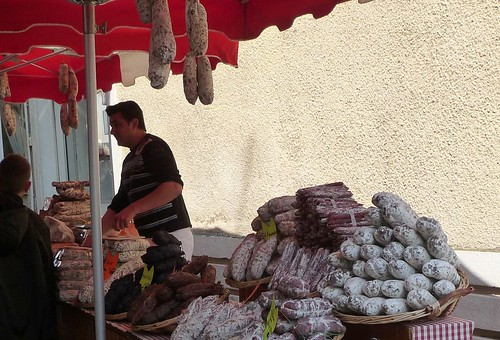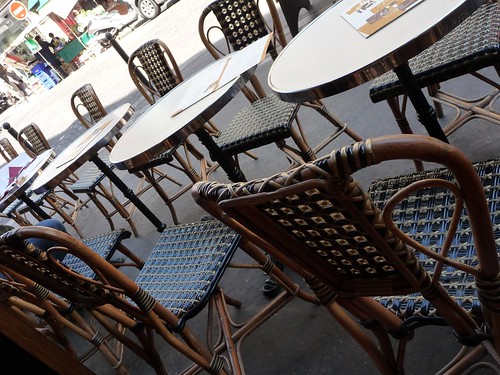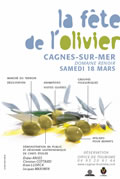
Let me give you some hints: it’s located just outside the
peripherique of Paris, but still accessible by metro. You will find it on an island. You can only get there with the little boat taxi service. It has a couple of very nice
terrasses (outdoor dinning patios) which were put to full use this past weekend.
Despite missing out on all the nice weather, I’m glad I took this assignment. First, I met a fellow
cuisinière americaine (american female cook) who also does temp work but she does it in addition to her full-time job at a 2-star michelin restaurant. I must admit it was a breath of fresh air and we were "sisters" for the day, as everyone said. We were the only female cooks there....and we were both Americans! "What is with this?" they all asked. "We have two americans here? Why do all the americans want to come here?!" It was cute.
Second, I got a chance to practice my knife skills. And how. I got my callous back in a mean way! Many in the kitchen world look at "the callous" as a source of pride – it shows you've done a thing or two with the knife. It forms at the place where the top of the blade of your knife rests (rubs really) against your index finger. Shake a cook’s hand, and you’re apt to understand what I’m talking about.
Third, I got to see a service for over 400 people. (This explains my callous!). To put it into proportion, at school or at prior restaurants where I worked, the highest number of covers I saw was 70 (that's kitchen speak for # of seats). This weekend was an absolutely beautiful day & everybody seemed to come to the island. Sunday's lunch service never wanted to end. It was order after order after order after order....nonstop....like a marathon. Unbelievable. And on top of it, there were no order tickets. All orders were called out verbally. Think about that! We went through kilos of
coquilles saint jacques (scallops), gambas,
truite (trout), etc, etc. Yes, I worked the fish station. There's some karma out there that knows this is my preferred post. High volume, high turnover of stock, high level of intense activity. Fast and furious. Actually, I got a charge out of doing it.
Fourth, I worked in a kitchen that had a great ambiance. Dare I say that there were smiles on their faces. Even the
chef-second was smiling & laughing (he's the guy in charge when the real chef is away, on vacation as was the case). He was jolly for pete's sake. I never met a jolly "chef" before. I thought they were all grumpy, stressed out or above the fray (I'm talking Paris here) . Despite the intense work load, everyone at this restaurant was easy-going and at ease.
Oh, and here’s another first: I heard several compliments throughout the services. "Bravo" whenever I brought a plate to
le pass (the counter where the servers pick them up). "Très bien'" often at the
poste de travail (station). And, at the end of service the chef said “
Bonne service tout le monde" (Good service everyone). And I even received a few extra kind words, “beautiful” work, bravo, and merci. Can you believe it?
With the weekend behind me, working those crazy hours of
coupure (double shift), I felt total exhaustion like I hadn't felt in a while. But it’s a good tired - when done in short spurts. I would gladly go back there. Interestingly enough, for the high workload involved in preparing the
mis en place and producing the service, I actually worked less hours per day than I had last year. I would even describe the hours as reasonable. For example, we finished at 11:15 on a Saturday night. And we started at 9:30 am each morning... So there's hope on the horizon - a kitchen with good esprit, good team, good hours, can exist.

Any guesses as to where I worked this weekend? OK, I'll just tell you: Le Chalet des Iles. Located on the Lac Inferieure in the Bois de Bologne (
Lac Inferieure, curiously enough, is not "inferior" at all - it is the bigger of two lakes and it actually sits on top of its small neighboring "pond"...yet another example of the french logic! I don't try to figure it out.)
Address:
Le Chalet des Iles
Lac Inferieur du Bois de Boulogne
Porte de la Muette 75016























 I started by taking a tram to go to the Concertgebouw, to get the season's program - because yes, I am planning to come back. Trams are an alternative means of transportation to the bike, the real "classic". The Dutch do not mind the rain and do not use "bike capes" to cover themselves when it rains! Trams are also definitely better if you plan to spend the day touring.
I started by taking a tram to go to the Concertgebouw, to get the season's program - because yes, I am planning to come back. Trams are an alternative means of transportation to the bike, the real "classic". The Dutch do not mind the rain and do not use "bike capes" to cover themselves when it rains! Trams are also definitely better if you plan to spend the day touring. From there, across the street, I had a view of the Museum Plein and its impressive modern building that houses the
From there, across the street, I had a view of the Museum Plein and its impressive modern building that houses the  It's a short walk to the
It's a short walk to the 

 But I also love cows, and found this 17 C pair at a specialist in antique Delft porcelain simply delightful. Though the price tag was a shock: 13,500 Euros! I'll pass - but aren't they beautiful.
But I also love cows, and found this 17 C pair at a specialist in antique Delft porcelain simply delightful. Though the price tag was a shock: 13,500 Euros! I'll pass - but aren't they beautiful. 50 tulips for 10 Euros ... I couldn't resist and bought a bunch of white ones, plus plenty of bulbs for my Parisian deck.
50 tulips for 10 Euros ... I couldn't resist and bought a bunch of white ones, plus plenty of bulbs for my Parisian deck. 
 On my way home I bought mussels for our evening meal! Miam! I fried a shallot in olive oil, added 1/4 cup of chopped parsley, a glass of dry white wine, and the mussels. Cover and let open over low heat. Toss them now and then. When they are open, serve immediately.
On my way home I bought mussels for our evening meal! Miam! I fried a shallot in olive oil, added 1/4 cup of chopped parsley, a glass of dry white wine, and the mussels. Cover and let open over low heat. Toss them now and then. When they are open, serve immediately. 



 I had the antipasto de la casa, an abundant plate of locals cold cuts (bresaola, parama ham, coppa) with a side dish of vegetables (pictured above): pickeled onions, artichokes, and beans. All delicious. I had this and dessert as a full meal other days!
I had the antipasto de la casa, an abundant plate of locals cold cuts (bresaola, parama ham, coppa) with a side dish of vegetables (pictured above): pickeled onions, artichokes, and beans. All delicious. I had this and dessert as a full meal other days!  Among the many primi piatti, mostly different types of pasta, I chose the simple fresh tagliatelle al pomodoro (fresh tomato sauce) with a leave of fresh basil.
Among the many primi piatti, mostly different types of pasta, I chose the simple fresh tagliatelle al pomodoro (fresh tomato sauce) with a leave of fresh basil.  We had the pesce del lago as secondi piatti: a grilled lake di Como fish the size of a very large sardine.
We had the pesce del lago as secondi piatti: a grilled lake di Como fish the size of a very large sardine.  Are you already feeling you had too much? No? Good, because then comes the cheese: a local mountain cow milk cheese (aged about three months).
Are you already feeling you had too much? No? Good, because then comes the cheese: a local mountain cow milk cheese (aged about three months).  And as you have guessed, I am a fan of Tiramisu, so I gave it a try!
And as you have guessed, I am a fan of Tiramisu, so I gave it a try!  It was too sunny outside and the dining room in the first floor, a cozy room with only five tables, had a splendid view! What agreat Friday! I had only mineral water, wine does not do me any good for lunch when it's hot.
It was too sunny outside and the dining room in the first floor, a cozy room with only five tables, had a splendid view! What agreat Friday! I had only mineral water, wine does not do me any good for lunch when it's hot. 













